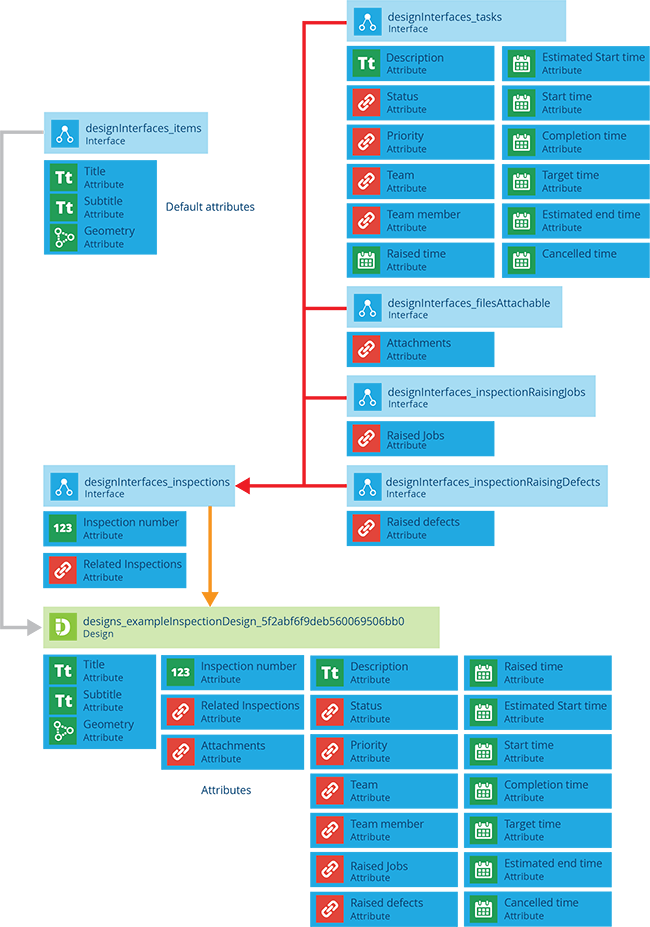Job designs
Represent a type of job
CausewayOne Asset Management lets you plan and perform any kind of work that needs doing. Maintain your organisation's assets and fix reported defects as they arise. Attach photos to record completed work.
To get started, you need to represent those jobs in CausewayOne Asset Management:
-
Create a design for each job type.
-
On each job design, add attributes for any extra data points you want to record about that job type. This may include implementing one or more interfaces to inherit their attributes alongside the ones on the design.
-
Create items of job designs to represent work tasks.
If you want to quantify and cost job requirements:
-
Create work items to represent individual units of work that any job may require, e.g. billable time, materials, equipment, staff.
-
On each job item, add job work items to represent the requirements of that particular job.
Create a job design
To create a design that represents a type of job:
-
On the start screen, select Create design. If you already have one open, select Create design in the top-right corner instead.
-
Choose the Job design type.
-
Fill in the details and then select Create design.
You can then edit the design to manage its attributes, links and other properties.
Standard job design details
All job designs implement the Jobs interface. Therefore, all job items inherit a standard set of properties and attributes. Required attributes are marked with an * asterisk.
Details
If left blank or unchanged, the job design will inherit the following properties:
-
Applies to - to be usable, a job design must be applicable to one or more designs. This makes it selectable when creating jobs for items of those designs. If an interface is added to this list, the job design will apply to all designs that implement it.
For example, a Tree Surgery Jobs design could apply to a Trees design.
To add one to the list, select Add applies to and choose a compatible design/interface. To remove one from the list, select its button.
-
Collections - job items can belong to any collection except for Inventory.
-
Geometry - is optional and all geometry types are allowed.
-
Icon -
icon-job -
Colour -
#e9225b -
Title -
JOB-Xwhere X is the value of the Job Number attribute.
Attributes
The following attributes are inherited from the implemented interfaces:
-
Job Number * - a unique ID number. This is automatically incremented, so the field isn't shown when creating/editing a job. By default, it's displayed in the title of job items for easy identification.
NoteYou can configure any Number attribute to automatically increment in this way.
-
Total Estimated/Actual Cost - the sum of the Estimated Cost or Actual Cost attributes on all job work items belonging to the job. These totals are automatically computed whenever a job work item is added, removed or edited. They aren't shown when creating/editing a job, or when the job has no job work items.
-
Description - text that typically describes any details of the job not covered by its other attributes.
-
Raised Time - when the job was created.
-
Issued Time - when the job was assigned to a team or team member.
-
Estimated Start/End Time - when the job is expected to be started or ended.
-
Start Time - when work on the job began and its status was changed to In Progress.
-
Completion Time - when work on the job finished and its status was changed to Completed.
-
Cancelled Time - when the job was closed prematurely and its status was changed to Cancelled.
-
Price Multiplier - a percentage adjustment to the calculated job cost, where
1.0represents 100%, e.g. a value of0.8will decrease the job cost by 20%. -
Price Adjustment - a numerical adjustment to the calculated job cost, e.g. a value of
-100.50will decrease the job cost by that amount.
Link attributes
The following Link attributes are inherited from the implemented interfaces:
-
Job Work Items - formalised units of work required for the job, which can be quantified and costed. Created from defined work items. To learn more, see Job work items on Asset Classic.
-
Related Jobs - links to any other jobs related to the job.
-
Budget - links to a budget. When set or unset, it will overwrite the Budget attribute on all job work items belonging to the job. The Estimated Cost or Actual Cost of each job work item is then deducted from the value of the relevant budget period (if defined), based on the job's most relevant Date Time attribute.
Details
The budget period is determined by one of these job attributes, in descending order of priority:
- Issued Time
- Raised Time
- Estimated Start Time
- Start Time
- Completed Time
- Estimated End Time
- Target Time
- the current date and time
-
Attachments - links to any uploaded files related to the job.
-
Status * - links to a task status indicating which stage the job is currently at, e.g. Proposed, Completed.
-
Priority - links to a task priority indicating how urgently the job needs to be completed.
-
Team - links to the team assigned to perform the job.
-
Team Member - links to the team member assigned to perform the job.
-
Reports - links to any generated reports involving the job.
-
Jobs Inspections - links to any inspections examining the output of the job.
-
Fixed Defects - links to any defects fixed by the job.
Interfaces
The following interfaces are inherited directly:
- Jobs
The following interfaces are inherited indirectly via the above interfaces:
-
Files Attachable
-
Tasks
-
Uplift
-
Items with Reports
-
Jobs With Inspections
-
Jobs Fixing Defects
